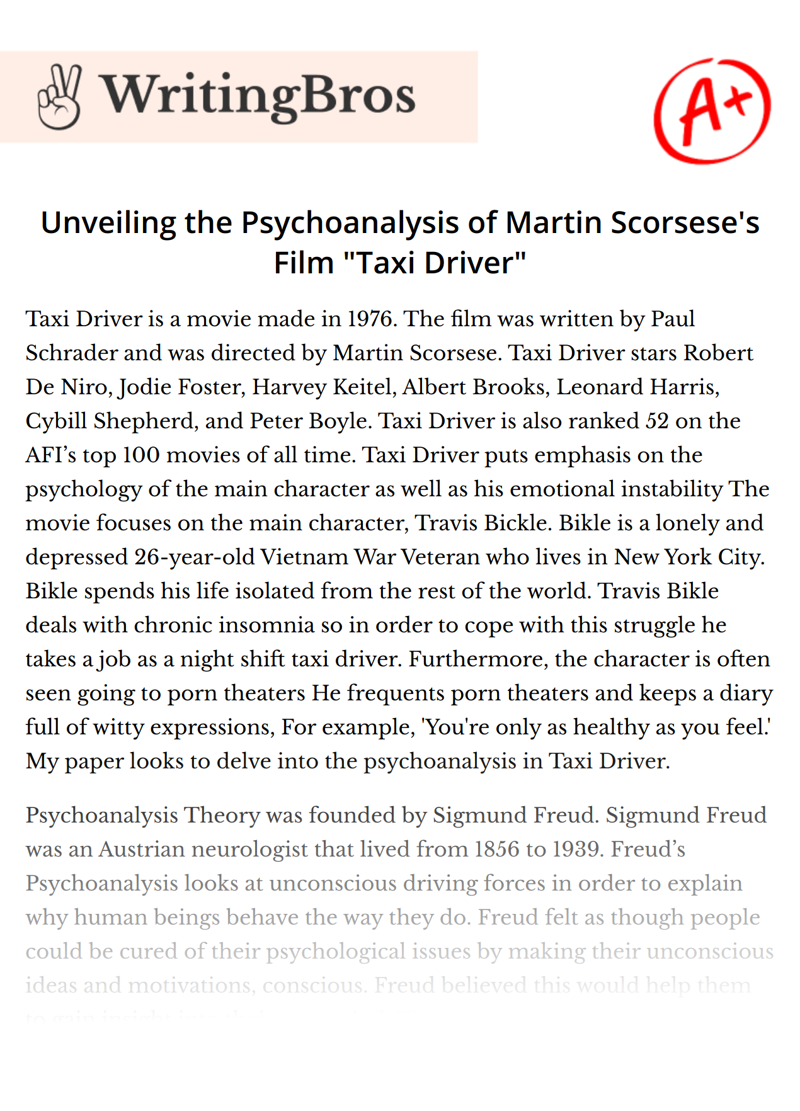Unveiling the Psychoanalysis of Martin Scorsese's Film "Taxi Driver"

Taxi Driver is a movie made in 1976. The film was written by Paul Schrader and was directed by Martin Scorsese. Taxi Driver stars Robert De Niro, Jodie Foster, Harvey Keitel, Albert Brooks, Leonard Harris, Cybill Shepherd, and Peter Boyle. Taxi Driver is also ranked 52 on the AFI’s top 100 movies of all time. Taxi Driver puts emphasis on the psychology of the main character as well as his emotional instability The movie focuses on the main character, Travis Bickle. Bikle is a lonely and depressed 26-year-old Vietnam War Veteran who lives in New York City. Bikle spends his life isolated from the rest of the world. Travis Bikle deals with chronic insomnia so in order to cope with this struggle he takes a job as a night shift taxi driver. Furthermore, the character is often seen going to porn theaters He frequents porn theaters and keeps a diary full of witty expressions, For example, 'You're only as healthy as you feel.' My paper looks to delve into the psychoanalysis in Taxi Driver.
Psychoanalysis Theory was founded by Sigmund Freud. Sigmund Freud was an Austrian neurologist that lived from 1856 to 1939. Freud’s Psychoanalysis looks at unconscious driving forces in order to explain why human beings behave the way they do. Freud felt as though people could be cured of their psychological issues by making their unconscious ideas and motivations, conscious. Freud believed this would help them to gain insight into their own mind. The main goal of psychoanalysis therapy is to release repressed emotions and experiences. Freud thought that making the conscious the unconscious would provide people with a healing effect only if the person was able to be healed.
Psychoanalytic film theory occurred in two separate and distinct periods. The first of the two began in the late 1960s and went into the early 1970s. This wave focused on a formal critique of cinema’s distribution of principle beliefs. A few of the most prominent people of this first period of psychoanalytic film theory, were Christian Metz, Jean-Louis Baudry, and Laura Mulvey. They took their central inspiration from aFrench psychoanalyst. This psychoanalyst’s name was Jacques Lacan, and they most often read Lacan through the Marxist philosopher Louis Althusser’s account of subject formation. The second wave of psychoanalytic film theory has also had its basis in Lacan’s thought, though with a significantly different emphasis.
There was a demonstration of psychoanalytic film theory in the late 1980s and early 1990s, which continues to remain relevant even today. This new wave of film theory shifted the focus from cinema’s ideological work to the relationship between cinema and trauma that disrupts the functioning of ideology. Although psychoanalytic film theorists continue to discuss cinema’s relationship to ideology, they have ceased looking for ideology in the cinematic apparatus itself and begun to look for it in filmic structure. Cinema remains a site for the dissemination of ideology, but it has also become a potential site of political and psychic disruption.
The main themes that can be taken from the film Taxi Driver include false ideals, and alienation leading into fragmentation, these being social and psychological problems stemming from capitalism and imperialism.
Cite this Essay
To export a reference to this article please select a referencing style below

